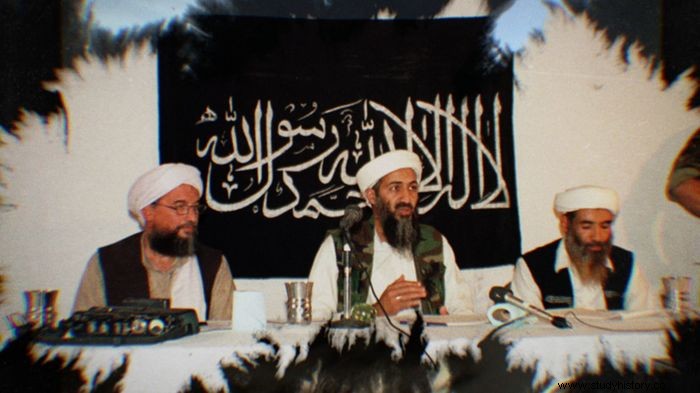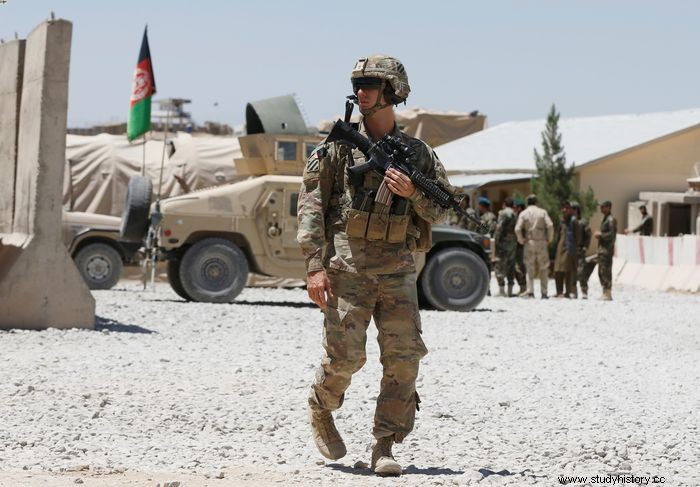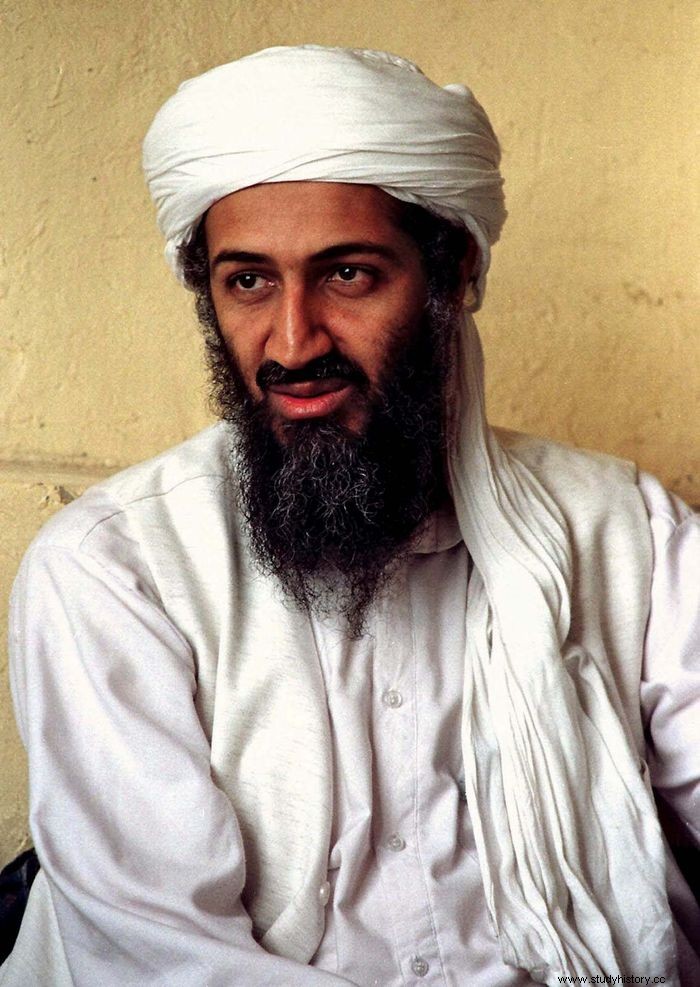9/11 is a day to remember! A tragic day for Americans and a significant turning point in world history. It was the day of the 9/11 terrorist attacks! On the day the World Trade Center was razed to the ground, the highest security infrastructure, the Pentagon got a hit and the Americans lost their loved ones. It was also the day when the hunt for the most wanted terrorist on the planet (also probably the most hunted person on earth), Osama Bin Laden also started!
As the United States and the world remember and commemorate the historic 9/11 terrorist attacks on the 20th anniversary, let's look at the incident, the planning, the attack, the aftermath and all about 9/11.

9
On September 11, 2001, 19 al-Qaeda-linked militants hijacked four planes and carried out suicide attacks on US targets. Two planes attacked the twin towers of the World Trade Center in New York City, a third plane hit the Pentagon just outside Washington, DC, and a fourth plane landed in a field in Shanksville, Pennsylvania. Nearly 3,000 people died in the September 9 terrorist attacks, which triggered massive US counter-terrorism programs and marked the presidency of George W. Bush.
The attacks on New York City and Washington, DC resulted in a large amount of death and destruction, in addition to a massive US campaign against terrorism. The attacks hit New York police and firefighters hard:hundreds of police and firefighters died on the way to the scene.
The planning behind the attack
The 9/11 terrorist attacks were partially triggered by Osama bin Laden, the leader of the militant Islamic group al-Qaeda, which contained a misconception of the United States in the months before the strikes. Bin Laden became increasingly convinced that America was weak in the years leading up to the attacks, according to Abu Walid al-Masri, an Egyptian who was a bin Laden aide in Afghanistan in the 1980s and 1990s.
What triggered the whole attack was America's withdrawal from Lebanon, Somalia and Vietnam. Bin Laden structured his belief that the United States was a weak country because they fled Somalia after the naval barracks. Again in 1993, after 18 American servants died in Mogadishu, they left Somalia. The cherry on top was when they withdrew their forces from Vietnam also in the 1970s. This paved the way for the structure of his plan to further reduce US power.
Khalid Sheikh Mohammed
Khalid Sheikh Mohammed, often referred to as "KSM", spent his childhood in Kuwait and was a critical operations planner for the 9/11 attacks. He joined the Muslim Brotherhood when he was 16 years old and then went to college in the United States, graduating from North Carolina Agricultural and Technical State University in 1986. He went to Pakistan and then Afghanistan to carry out jihad against the Soviet Union, which had invaded Afghanistan in 1979.
Khalid Sheikh always had extremist ideas that could never take shape. But his goals faded rather. Yosri Fouda, a journalist from Al Jazeera, met Khalid Sheikh Mohammed in 2002 and learned about his conspiracy known as "Bojinka", in which he wanted to blow up a dozen American planes in Asia in the mid-1990s. Keeping the goal, meeting bin Laden and taking care of him was the best opportunity for him to achieve his long-awaited dream.
In Tora Bora, Afghanistan, in 1996, Khalid Sheikh met Mohammed Bin Laden. According to the 9-11 Commission (formally the National Commission on Terrorist Attacks Upon the United States), this was created in 2002 by President George W. Bush and the US Congress to investigate the attacks in 2001. The Commission explains in detail that Khalid Sheikh Mohammed la put forward a proposal for an operation that would involve training pilots who would crash planes into buildings in the United States at the time.

Al Qaeda
The 9/11 terrorist attacks proved al-Qaeda's global reach. The action took place all over the world, with planning meetings in Malaysia, and operators learned to fly in the United States. There were also plot managers in Hamburg, Germany, money transfers from Dubai and the recruitment of suicide actors from all over the Middle East. Al-Qaeda's leaders in Afghanistan have continuously overseen each of the activities.
Although Afghanistan was crucial to al-Qaeda's emergence, the experience of the West made some of the plotters both more eager and able to carry out the attacks. Mohammed Atta and the other gang members in Hamburg arrived in Afghanistan in 1999, just as the 9/11 plot was beginning to take shape. Bin Laden and his military chief, Muhammad Atef, decided that Atta and his other Western-trained jihadists were far better qualified to carry out the attacks on Washington and New York than the troops they had already recruited. Thus, Atta was appointed chief of operations.
The hijackers, most of whom were Saudi Arabians, had already established themselves in the United States well before the attacks. They traveled in small groups and received commercial flight training for some of them. During his time in the United States, Atta Ramzi Binalshibh, one of the most important planners, sent e-mail updates on the site's progress. On August 29, 2001, Atta Binalshibh called early in the morning, claiming he had a puzzle to solve:"Two sticks, a dash and a cake with a stick down - what is it?" Binalshibh acknowledged that Atta told him that the attacks would take place in two weeks - the two sticks were the number 11 and the cake with a stick down number 9. Thus, when all the pieces were put together, the attacks would take place on 11- 9 or 11 September. .

9/11 terrorist attack
On September 11, 2001, the attackers boarded four domestic aircraft at three East Coast airports. The disabled crews shortly after takeoff. The hijackers then took possession of the planes, all huge and loaded with petrol and headed for the west coast. After leaving Boston, the first plane, American Airlines flight 11, piloted into the tower at the World Trade Center in New York City at 8. Most people assumed that it was first an accident that involved a small commuter plane. However, United Airlines Flight 46, which originates from Boston, hit the South Tower 175 minutes later. There was no doubt that the United States was under attack at the time.
At 9 a.m., American Airlines flight 37, which had taken off from Dulles Airport in Washington, DC, collided with the southwest side of the Pentagon (just outside the city) and set fire to that area of the building. The Federal Aviation Administration issued a nationwide ground stop minutes later. The fourth plane, United Airlines Flight 93 from Newark, New Jersey, crashed near Shanksville in rural Pennsylvania an hour later (10:03). The passengers tried to overpower the assailants after being informed of the incidents via mobile phone.
The heavily damaged south tower of the World Trade Center collapsed at 9:59 p.m. The North Tower collapsed 29 minutes later. The streets of Lower Manhattan were flooded with clouds of smoke and debris. As they tried to run out of the raging debris, office workers and residents panicked. As the world tried to understand the extent of the damage, rescue operations began. Nearly 3,000 people died, including 2,750 in New York, 184 in the Pentagon and 40 in Pennsylvania, and all 19 terrorists. In addition, more than 400 police officers and firefighters lost their lives in New York City.
The aftermath of the 9/11 terrorist attacks
The emotional toll of the attacks, especially the collapse of the Twin Towers, New York City's most visible landmark, was enormous. Unlike the relatively isolated site of the 1941 Pearl Harbor attack, the World Trade Center was in the heart of New York. Hundreds of thousands of people observed the attacks on their own (many spectators photographed or videotaped the events). In addition, millions more watched the disaster unfold on television. The footage of the attacks and the scenes of crowds, some with pictures of missing loved ones, who gathered at "Ground Zero" were seen in the media countless times in the days after 9/11.
Furthermore, global markets shook. Damage to Lower Manhattan's infrastructure and concerns about stock market panic forced New York markets to close for four trading days. After that, the stock market saw a record loss. In addition, tens of thousands of travelers were stranded across the United States due to the attacks. It was as if the authorities blocked American airspace for commercial aircraft until 13 September. Regular service, with stricter security procedures, did not return for many days.
Al-Qaeda scored a significant tactical victory with the 9/11 attacks. The well-coordinated attacks hit many places deep inside the enemy's heart. Television visions of the attacks amplified the attacks of an audience of unimaginable millions. September 11 The "propaganda of the deed" took place in the world media capital. This ensured that the tragedy received the greatest possible attention. A large audience around the world had not observed a terrorist attack unfold in real time since the kidnapping and killing of Israeli athletes at the Munich Olympics in 1972. If al-Qaeda was a relatively unknown organization before 9/11, it became hugely popular after the attacks.

9/11 Terrorist attacks aftermath
Evidence obtained by the United States quickly persuaded most governments that the Islamic militant group al-Qaeda carried out the terrorist attacks. Previous terrorist attacks against Americans were also linked to the group, and bin Laden had made many anti-American comments. Furthermore, Al-Qaeda was based in Afghanistan and developed a close relationship with the country's ruling Taliban militia. It later rejected US requests for bin Laden's extradition and the end of al-Qaeda activities.
The North Atlantic Treaty Organization (NATO) relied on Article 5. It aims to empower members to respond collectively in self-defense for the first time in its history. On October 7, US and allied military forces launched an operation against Afghanistan. Thousands of militants were killed or captured within months. It made Taliban and al-Qaeda leaders hide.
Furthermore, the US administration launched a joint effort to seek additional al-Qaeda members and sympathizers around the world. This made counter-terrorism a priority in US foreign policy. Meanwhile, security measures in the United States have increased significantly in places such as airports, government buildings and sports venues. US PATRIOT law significantly increased the FBI and other law enforcement agencies, but temporarily, the search and surveillance forces. Congress passed it immediately to help the domestic response. In addition, the authorities formed the Department of Homeland Security at the cabinet level.
Bin Laden miscalculated the possible US responses to the 9/11 attacks. He thought it would take one of two forms:
- a possible withdrawal from the Middle East in line with the US withdrawal from Somalia in 1993
- or ineffective cruise missile attacks such as al-Qaeda bombing of US embassies in Kenya and Tanzania in 1998.
None of these situations happened.

The hunt for Osama bin Laden
President Bush said in September 2001 that he wanted Osama bin Laden arrested, dead or alive. A $ 25 million reward came for information leading to bin Laden's death or imprisonment. Bin Laden escaped arrest several times. Once was in December 2001, when US forces tracked him down to the Tora Bora Mountains in eastern Afghanistan. Bin Laden's trail became cold after that, and the authorities believed that he was hiding somewhere in the Afghan-Pakistani tribal areas. Then, on the orders of US President Barack Obama, a small team of US Navy SEALs invaded bin Laden's compound in the early morning hours of May 2, 2011. They shot and killed the al-Qaeda leader in Pakistan, where he lived in the garrison town of Abbottabad. Justice for the 9/11 terrorist attacks and for the United States!

The current scenario
On November 3, 2014, the One World Trade Center, a 1,776-foot-tall skyscraper, became a dramatic new icon on the Manhattan skyline. It filled the physical and symbolic gap after the fall of the Twin Towers. The National September 11 Memorial and Museum exists next to the One World Trade Center. Twin 1-acre reflective pools occupy the footprints of the Twin Towers on the 8-acre memorial site. The pools include North America's largest man-made waterfalls. They have bronze panels with the names of the victims of the 9/11 attacks. In addition, the names of the six people who were killed in the bombing of the vehicle at the World Trade Center in February 1993.
The museum consists of a pavilion with glass. It is an atrium that has two 80-foot (24-meter) triangular-shaped steel columns on the face of the North Tower. Each of the 2:983 tiles in the museum's Memorial Hall (representing the victims of the September 2001 and February 1993 attacks) is a blue watercolor painted by artist Spencer Finch to mimic the color of the sky on September 11, 2001.
The foundation hall of the museum is a room of almost 15,000 1,400 square meters (36 square meters) with high ceilings. It includes part of a surviving wall from the World Trade Center and shows the "Last Column". It is an 11 foot (9 meter) steel beam to which workers attached messages and posters during Ground Zero cleanup operations. In addition, there is a multimedia installation that shows the global impact of the terrorist attacks of 11/43 September. It runs along the ramp that leads into the museum. It includes recorded memories of people from 28 nations in XNUMX languages.
